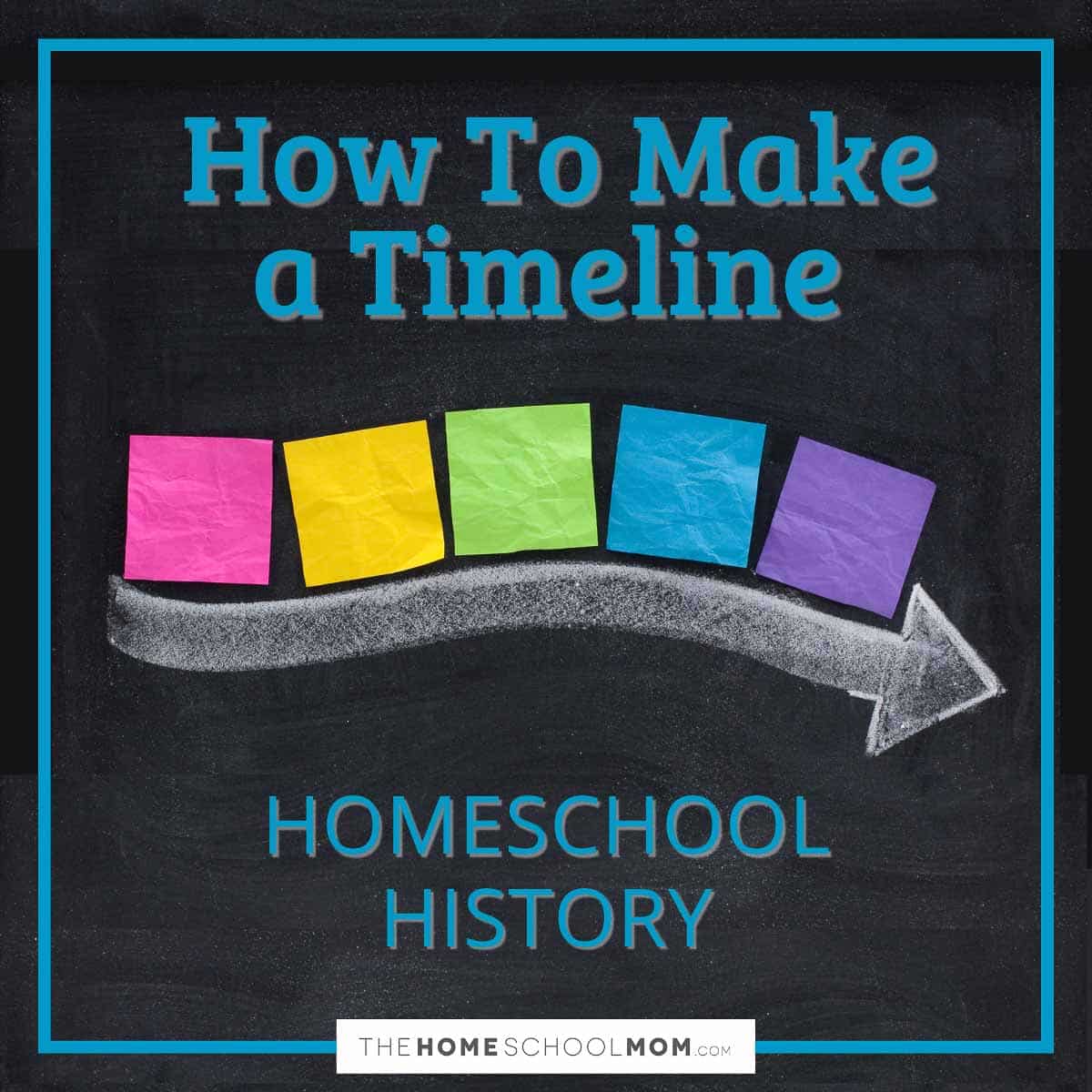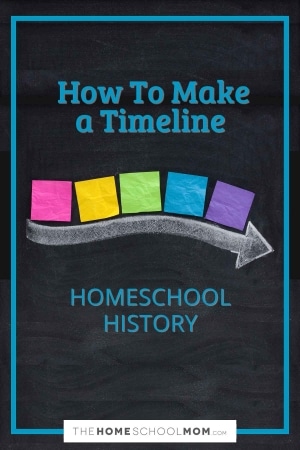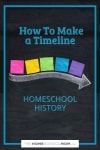I receive many questions from new and veteran home educators over the course of a year. In the past two months, however, there has been one question that has surfaced more than any other and that is... "How do we make a timeline?" This is a great question and armed with knowledge and the right tools, it is not as hard as it might seem.
Once you have decided that your students would gain tremendous benefit from seeing the progression of history in the form of a timeline, the first obstacle that crops up is, "How do we start?"
Some of the questions that arise when constructing a timeline are from not knowing what the date increments should be, how far apart they should be spaced, what format should be used and what exactly should go on it.

Timeline Format
We will tackle each one of these questions, but let's start with the third one about format. A timeline can be constructed in a variety of formats, but there are three major categories:
- wall timeline
- book timeline
- computer timeline
Each one is fairly self-explanatory, but for the sake of clarity, let's define each one.
A wall timeline would be attached to or hung upon the wall. When no longer in use, it may be taken down and stored by folding like an accordion or rolling it up. A wall timeline can either be a finished product for reference purposes only, a pre-printed banner with date increments only, or entirely homemade. As interesting as a reference timeline can be for adults, it is not the educational tool that the latter two options provide.
A book timeline as well can be a finished product, such as the Wall Chart of World History. This is a fabulous book and a great reference for adults or teens. Again, it is not the ideal educational tool for students in 4th through 12th grade, because students in this age bracket need a tangible activity to cement their learning. (As an aside, timelines do not have significant meaning for students 3rd grade and under. At this age, they are still grasping the concept of time.) The other options for book timelines would be a pre-printed hardcover book with date increments only, a binder with printed timeline sheets, or a homemade timeline book assembled in a notebook, scrapbook or sketch book.
A computer timeline requires software, which can be anything from the most basic of applications such as Microsoft Word or Excel (or similar word processing and spreadsheet applications) to a program that has been developed specifically for the purpose of creating historical timelines on the computer. Two such programs are the Easy Timeline Creator and TimeLiner 5.0. Both of these programs have been developed for students to make timeline creation at the computer desktop a snap. [Ed. note: Easy Timeline Creator is no longer available, but TimeLineJS is an open-source timeline creator that uses Google Sheets.]
Timeline Spacing
Once a format has been decided upon, the time period and date increments need to be mapped out. Decide if your timeline will cover the span of recorded history (generally from early civilizations around 5000BC to the present) or just a segment of history (for example: World War II - 1939-1945).
This next part is subjective, but you will need to decide how much space you would like to allot to your timeline. You may be limited by wall space and this factor might play into your decision about which format to use as well.
If you are working with a book format or on the computer, space is not particularly an issue. One rule of thumb, however, is to give yourself more space the more recent the history being studied. For example, a page per one or two hundred years is sufficient for Ancient history, (in fact using this amount will result in many blank pages towards the beginning) but you will need at least a page per decade for the 20th century. Perhaps even more.
Below are some guidelines to get started. As much as possible, determine to keep date increment spacing consistent on your planned timeline project. If you are using a wall timeline, consider choosing a time period rather than the whole span of recorded history.
You can change out timelines when you have filled up the first one. This is not a bad idea for your book or computer timeline either, as it breaks the project down into a manageable sized chunk. This can be a very helpful plan for children, especially those that are easily overwhelmed by large projects.
For the wall:
| Time Period | Date Increments | Space Needed |
| Ancient History | allow 3-6 inches of space per 100 years | This will be over 10 feet of timeline if you cover as much as 5000BC – 400AD |
| Medieval History | allow 10 – 12 inches of space per 100 years | This will result in 10 -12 ft. of timeline if you cover as much as 400AD – 1600AD |
| Renaissance or New World History | allow 12 inches of space per 25 years | This will result in 10 feet of timeline if you cover as much as 1600 – 1850 |
| Modern History | allow at least 8 inches of space per decade | This will result in 10 feet of timeline is you cover as much time as 1850 – 2000 |
Note: Before you begin to mark the date increments on your homemade wall timeline, draw a straight line horizontally along its length. Use butcher paper, computer printout paper or the unprinted ends of a newspaper roll (ask for this at your local paper - it is either free or cheap). Also note that Knowledge Quest sells wall timelines with the date increments pre-marked.
For a book:
| Time Period | Date Increments | Space Needed |
| Ancient History | allow a page for every 100 – 200 year span | With 100 years per page, your book will number at least 54 pages if you cover 5000BC – 400AD |
| Medieval History | allow a page for every 50 – 100 years | 50 years per page will result in 24 pages if you cover as much as 400AD – 1600AD |
| Renaissance or New World History | allow a page for every 10 – 25 years | 25 years per page will result in 10 pages and 10 years per page will result in 25 pages if you cover as much as 1600 – 1850 |
| Modern History | allow a page for every 5 – 10 years | 10 years per page will result in 15 pages and 5 years per page will result in 30 pages if you cover as much as 1850 – 2000 |
Note: Before you begin to mark the date increments in your homemade timeline book, draw a straight line horizontally along the mid to upper portion of each page. Use notebook paper, scrapbook papers or an artist's sketchpad Also note that Knowledge Quest sells a blank timeline book entitled Wonders of Old which has the date increments pre-marked.
One final idea for your book timeline is to insert blank half pages between the full pages that you have created above to allow for expansion if your student runs out of room on the pages provided. The concept of the half pages is that the page would sit below the running line on the full pages giving the page its date increments.
For the computer:
The beauty of a computer generated timeline is that it only uses the space that it needs. It can expand to include as many details as your student would like to include on it and there are no empty holes where information has been left out.
This writer is greatly impressed with the software program Easy Timeline Creator. It is flexible and user-friendly and great for the student who would prefer to build his timeline from the computer.
Timeline Contents
The final and perhaps most important question is… What should go on our timeline?
The short answer… anything that your student is currently studying that falls within the time period that she is charting. This can be historical events, political figures, artists and musicians, discoveries, inventions, scientists, religious figures and events, literature, great writers, etc.
Anything that is worthy of studying is worth recording on the timeline as the timeline gives the snapshot perspective of when things happened and in what order.
A related question that pops up is where on the timeline should people be recorded - at their birth, or date of significant achievement? There is no right answer. And a good argument can be made for either alternative or for recording both.
Information can be recorded on timelines by writing events down by hand, drawing pictures, sticking stickers, or gluing on pictures or pre-drawn timeline figures. Again there is no right answer, only personal preference.
The greater learning experience would come from drawing pictures and writing captions down by hand. Of course, if this causes frustration and resistance to the project by your students then we have defeated the point. Furthermore, if we as the parents cannot bear the scribble displayed on our walls and will only consent to a wall timeline if it is meticulously done, then prepared timeline figures may be the way to go.
Pictures for your timeline can come from magazine clippings, Google images, clip-art books and CDs. There are companies that have produced historical timeline figures so that you can have everything you need stored in one place for easy retrieval.
I am very impressed with the timeline figures drawn by Amy Pak entitled History Through the Ages. She has hand-drawn over 1,620 figures that include captions, ready to cut and paste onto your timeline. Sets are provided for ancient, medieval/renaissance and modern history.
A note on applying pictures or figures onto your timeline: a glue stick is a much better applicator than regular Elmer's glue. Glue dots work as well, but the edges do not get sealed down very well, leaving the possibility that the figures might get knocked off inadvertently.
Hopefully, the information provided here will arm you with the knowledge and motivation that you need to get started on that timeline project that you have been meaning to get to. Making a timeline with children can be a fun and rewarding experience. A great learning opportunity as well.





Thank you for this post! It is definitely helpful to get me started on this huge undertaking for the upcoming homeschooling year!!
Enjoy your timeline project, Cara, and have a great homeschool year!
Looking forward,
Jeanne
This is a pretty good article! Mind if I have a link from my website to yours as one of my tips??
We'd be happy for you to link to TheHomeSchoolMom, thanks!